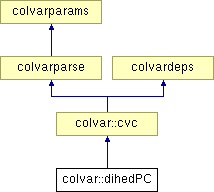
#include <colvarcomp.h>
Inheritance diagram for colvar::dihedPC:

Public Methods | |||
| dihedPC (std::string const &conf) | |||
| dihedPC () | |||
| virtual | ~dihedPC () | ||
| void | calc_value () | ||
| \brief Calculate the variable. More... | |||
| void | calc_gradients () | ||
| \brief Calculate the atomic gradients, to be reused later in order to apply forces. More... | |||
| void | collect_gradients (std::vector< int > const &atom_ids, std::vector< cvm::rvector > &atomic_gradients) | ||
| Re-implementation of cvc::collect_gradients() to carry over atomic gradients of sub-cvcs. More... | |||
| void | apply_force (colvarvalue const &force) | ||
\brief Apply the collective variable force, by communicating the atomic forces to the simulation program (Note: the ft member is not altered by this function) Note: multiple calls to this function within the same simulation step will add the forces altogether
| |||
| virtual cvm::real | dist2 (colvarvalue const &x1, colvarvalue const &x2) const | ||
| \brief Square distance between x1 and x2 (can be redefined to transparently implement constraints, symmetries and periodicities) colvar::cvc::dist2() and the related functions are declared as "const" functions, but not "static", because additional parameters defining the metrics (e.g. the periodicity) may be specific to each colvar::cvc object. If symmetries or periodicities are present, the colvar::cvc::dist2() should be redefined to return the "closest distance" value and colvar::cvc::dist2_lgrad(), colvar::cvc::dist2_rgrad() to return its gradients. If constraints are present (and not already implemented by any of the colvarvalue types), the colvar::cvc::dist2_lgrad() and colvar::cvc::dist2_rgrad() functions should be redefined to provide a gradient which is compatible with the constraint, i.e. already deprived of its component normal to the constraint hypersurface. Finally, another useful application, if you are performing very many operations with these functions, could be to override the colvarvalue member functions and access directly its member data. For instance: to define dist2(x1,x2) as (x2.real_value-x1.real_value)*(x2.real_value-x1.real_value) in case of a scalar colvarvalue type. More... | |||
| virtual colvarvalue | dist2_lgrad (colvarvalue const &x1, colvarvalue const &x2) const | ||
| \brief Gradient(with respect to x1) of the square distance (can be redefined to transparently implement constraints, symmetries and periodicities). More... | |||
| virtual colvarvalue | dist2_rgrad (colvarvalue const &x1, colvarvalue const &x2) const | ||
| \brief Gradient(with respect to x2) of the square distance (can be redefined to transparently implement constraints, symmetries and periodicities). More... | |||
Protected Attributes | |||
| std::vector< dihedral * > | theta | ||
| std::vector< cvm::real > | coeffs | ||
Definition at line 1176 of file colvarcomp.h.
|
|
|
|
|
Definition at line 419 of file colvarcomp_protein.C. References colvardeps::enable, colvardeps::f_cvc_explicit_gradient, colvar::cvc::set_function_type, colvarvalue::type, colvarvalue::type_scalar, and colvar::cvc::x. |
|
|
Definition at line 429 of file colvarcomp_protein.C. References colvar::cvc::atom_groups, and theta. |
|
|
\brief Apply the collective variable force, by communicating the atomic forces to the simulation program (Note: the ft member is not altered by this function) Note: multiple calls to this function within the same simulation step will add the forces altogether
Implements colvar::cvc. Definition at line 483 of file colvarcomp_protein.C. References coeffs, colvarmodule::cos, force, PI, colvarmodule::sin, and theta. |
|
|
\brief Calculate the atomic gradients, to be reused later in order to apply forces.
Reimplemented from colvar::cvc. Definition at line 452 of file colvarcomp_protein.C. References theta. |
|
|
\brief Calculate the variable.
Implements colvar::cvc. Definition at line 440 of file colvarcomp_protein.C. References coeffs, colvarmodule::cos, PI, colvarvalue::real_value, colvarmodule::sin, theta, and colvar::cvc::x. |
|
||||||||||||
|
Re-implementation of cvc::collect_gradients() to carry over atomic gradients of sub-cvcs.
Reimplemented from colvar::cvc. Definition at line 460 of file colvarcomp_protein.C. References colvar::atom_ids, colvar::atomic_gradients, coeffs, colvarmodule::cos, colvarmodule::integer_power, PI, colvarmodule::real, colvarmodule::sin, colvar::cvc::sup_coeff, colvar::cvc::sup_np, theta, and colvar::cvc::value. |
|
||||||||||||
|
\brief Square distance between x1 and x2 (can be redefined to transparently implement constraints, symmetries and periodicities) colvar::cvc::dist2() and the related functions are declared as "const" functions, but not "static", because additional parameters defining the metrics (e.g. the periodicity) may be specific to each colvar::cvc object. If symmetries or periodicities are present, the colvar::cvc::dist2() should be redefined to return the "closest distance" value and colvar::cvc::dist2_lgrad(), colvar::cvc::dist2_rgrad() to return its gradients. If constraints are present (and not already implemented by any of the colvarvalue types), the colvar::cvc::dist2_lgrad() and colvar::cvc::dist2_rgrad() functions should be redefined to provide a gradient which is compatible with the constraint, i.e. already deprived of its component normal to the constraint hypersurface. Finally, another useful application, if you are performing very many operations with these functions, could be to override the colvarvalue member functions and access directly its member data. For instance: to define dist2(x1,x2) as (x2.real_value-x1.real_value)*(x2.real_value-x1.real_value) in case of a scalar colvarvalue type.
Reimplemented from colvar::cvc. |
|
||||||||||||
|
\brief Gradient(with respect to x1) of the square distance (can be redefined to transparently implement constraints, symmetries and periodicities).
Reimplemented from colvar::cvc. |
|
||||||||||||
|
\brief Gradient(with respect to x2) of the square distance (can be redefined to transparently implement constraints, symmetries and periodicities).
Reimplemented from colvar::cvc. |
|
|
Definition at line 1182 of file colvarcomp.h. Referenced by apply_force, calc_value, and collect_gradients. |
|
|
Definition at line 1181 of file colvarcomp.h. Referenced by apply_force, calc_gradients, calc_value, collect_gradients, and ~dihedPC. |
 1.2.14 written by Dimitri van Heesch,
© 1997-2002
1.2.14 written by Dimitri van Heesch,
© 1997-2002